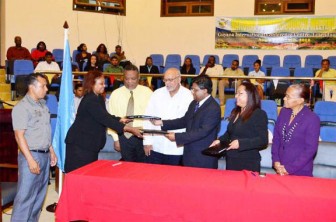The government and the United Nations Development Programme (UNDP) on Thursday signed a pact that will see an initial $360M of $1.2B being released for projects by Amerindian communities.
The UNDP is the partner entity for the Amerindian Development Fund (ADF) and in June, the Steering Committee of the Guyana REDD+ Investment Fund (GRIF) approved the Project Concept Note (PCN) for the fund enabling the UNDP to request up to US$1.8M ($360M) for project proposal preparation activities from the trustee of the GRIF, the World Bank. The GRIF is the mechanism through which monies from Norway’s five-year US$250 million forests partnership with Guyana are channelled to this country.
The expected outputs of this first phase are the creation of a functional, scalable and transparent disbursement mechanism; the strengthening of the capacity of theMinistry of Amerindian Affairs (MoAA) to plan, manage, and support community development; the funding of 15% of the Community Development Plans (CDPs) to test the disbursement mechanism; the improving of the planning, management, and support mechanisms in place for the implementation of the CDPs in select Amerindian communities; and the full Project Document prepared and submitted for approval.

Only a small portion of the US$70M of Norway funds available to Guyana for forest protection has been utilised
The Government Informa-tion Agency (GINA) reported that the inking of the agreement was witnessed by elected leaders of all Amerindian villages and will see funding to the tune of $1.2B deposited to the ADF through which an initial $360M will be made available for the execution of projects earmarked under the CDPs. Signing on behalf of the government was Minister of Finance, Dr. Ashni Singh and Minister of Amerindian Affairs Pauline Sukhai while UNDP Resident Represen-tative Khadija Musa signed for the agency.
President Donald Ramotar, Prime Minister Samuel Hinds, former Chairperson of the National Toshao Council (NTC), Yvonne Pearson and newly elected Chair, Derrick John witnessed the signing, GINA reported. It said that the government is looking to several other implementing partners like the UNDP coming on board and may soon see advances from the Inter-American Development Bank (IDB) which has already committed considerable resources and efforts in identifying project interests within the Low Carbon Development Strategy (LCDS).
President Donald Ramotar in his remarks hailed the Norwegian Government for their forthright, advanced, enlightened and tangible position in the fight against climate change, GINA reported. “All of us recognise the danger that climate change brings to the whole world and all of us carry some responsibility to fight against climate change and the Norwegians have shown a great clarity and purpose and for that reason we want to thank them and thank the international community,” he was quoted as saying.
GINA said that while expressing anticipation to have full support from all communities, the UNDP Representative called on leaders to not let this venture be a one-off initiative, but urged that they initiate projects that will ensure revenue continues to be injected into their communities. Credit was also given to Guyana’s former President and Champion of the Earth awardee Bharrat Jagdeo, who masterminded the LCDS model that promotes economic development and the maintenance of sustainable environmental health, GINA reported.
“We owe as a country and we owe as a world a debt of recognition… to those who have guarded these forests, for centuries before us,” Singh was quoted as saying. “We have always been unwavering in our recognition of the value of standing forests, in our recognition of the need for sustainable management of natural resources and of the need for responsibility towards the natural environment,” he said.




